Family History Numbering Systems
By Dale E. Lee
2021.09.08
Summary:
- Organization
- Types
- Pedigree
- Ahnentafel
- Numeric Numbering Systems
- Roman Numeral Numbering Systems
- Alphabetic Numbering Systems
- Last Name
- Others (Library, GEDCOM, etc.)
Detail:
- Organization
If you’ve followed The Seekerz’s advice and have requested and collected all the information you can from your family, as well as near and far relatives, you’ll find that you may be getting more information than you expected.
One of the most important things in Family History is to organize the information you are given.
These days we are given a lot of help in automatically organizing information we put into our desktop utilities and online repositories. But what if Old Aunt Evelyn didn’t have or didn’t use a computer when she pulled together all that information?
Now you will have one of two challenges, or maybe even both at the same time. The first is that she may have used a numbering system to organize her information that you may not be familiar with. The second is that the information may not be organized at all. This article addresses how to use numbering systems to help understand and organize your data.
For example, a friend has been letting his family know that he is interested in Genealogy for over a year. He recently brought a stack of papers to a local Family History Library and asked for help to decipher what the papers all meant. After perusing the papers and discovering many of them contained lists of people with associated unique numbers, we discovered that the lists were in reality indexes. The unique numbers represented a numbering system that had built-in generational and family ordering significance. Each list was a list of the descendants of a common ancestor displaying the relationship between the descendant and all preceding ancestors. We could literally trace the genealogy of each through the numbering system even though it was a simple index of descendants.
There are several major numbering systems used in Family History at this point. Although computer software tends to hide the complexities of numbering systems, and to often use their own proprietary systems, it may be important for you to understand numbering systems when dealing with off the grid information. For example, if you have a Family Organization and wish to publish a book of all of the descendants of a particular ancestor, as in the above example, using computer methods will be quite confusing and one of the systems below may be much more helpful.
- Types
There are two main types of numbering systems in use in Family History, and a few specialty types. The main types used are for either Ancestral numbering or for Descendant numbering. Both Ancestral and Descendant numbering systems have a deficiency due to the fact that they are based on starting at one particular Ancestor or one particular Descendant. Once the focus of the starting point for the numbering system changes, all the numbers in the whole system have to be adjusted. I am not aware of any system correcting this deficiency.
In addition to Ancestry and Descendant systems, Specialty numbering systems are used for Libraries, GEDCOM files, Hanging files, etc.
- Pedigree
One of the Ancestor numbering systems (as versus Descendant numbering) is a simple numbering of the first and last positions on a Pedigree Chart. Pedigree Charts are special in that they are binary in nature. Starting with yourself and going back one generation doubles the number of people. Going back another generation doubles it again, and so forth, each generation doubling the number of new people added to the chart.
Nowadays, computer software displays relational information in visual format instead of relying on IDs, but if you need to show the relationships on paper reports or charts, one way of doing so is to take the number of the ancestor in the last generation on the current Pedigree Chart and pull it through to the first individual on the next chart.
So for example, in a four generation Pedigree Chart, you would be the first person and the last generation on the chart would be four generations away from you, your Great Great Grandparents. In the example below you can see each individual in the Pedigree Chart is given a number. If there are multiple Pedigree Chart sheets, because the family has been able to extend back further than four generations, the way to continue the line would be to pull over each the people in the last column of individual four generation charts to a new chart where they would be the first on the next chart and then continue on back from there. There may be a temptation to use the number assigned to the ancestor on the first sheet, a number that would result in 16-32 being used for the continued sheets. However, this drops the numbers 1-15, and would continue dropping numbers the further back you go in the charting system.
A better approach would be to number the people in the last column from 1-16, as shown by the numbers enclosed in parenthesis to the right side of the page. This is fine for the second sets of Charts, but we also need a way to extend beyond that. A good way is to use the number from the second set as a prefix for the following generations of charts. So the chart that extends the Father’s Mothers’ Father’s Mother, number (6) in the illustration below, would be put on a new chart and the chart itself would be numbered as 6. At the point that the generations need to be extended an additional four generations, a person on the end column on the second layer of charts would concatenate the chart number they are on to which ever number 1-16 they are on in that chart and take that to the next chart, so for example the number 6.12, means the person is person #12 on Chart 6. This will now become the person #1 on Chart 6.12.
The reason this method is discussed is that the basics used in this example are also used in other methods. If you understand how each generation is linked to other generations and to other charts, it makes understanding Genealogical Numbering systems much simpler.
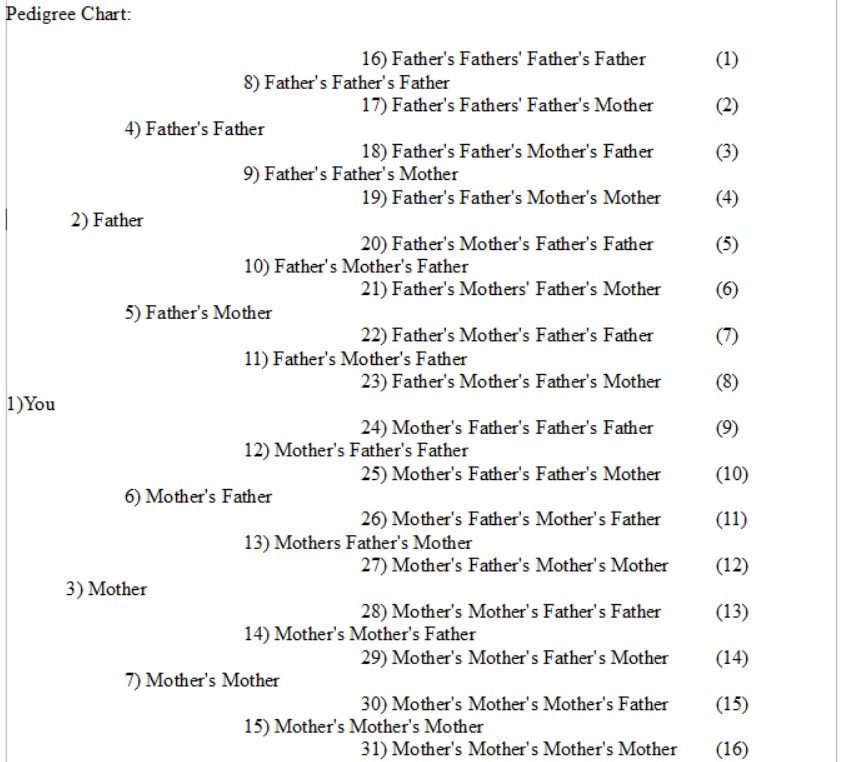
- Ahnentafel
The Ahnentafel numbering system also used to chart Ancestors. It uses the basics of the above, with the addition that the numbering system can be used to detect the generation and position within the generation as well as the sex of the ancestor, instead of the chart number and position within the chart number as in the prior example.
Wikipedia explains that Ahnentafel starts with the descendant of interest as number 1, and “The number of a person’s father is twice their own number, and the number of a person’s mother is twice their own, plus one. For instance, if John Smith is 10, his father is 20, and his mother is 21.” Additionally, each generation back becomes part of the number starting with generation 1 being the person of interest.
Thus “08-146 is the subject’s father’s father’s mother’s father’s father’s mother’s father.” The person of interest is 7 generations away from the ancestor, as they are the first generation of the 1-8 series. The number 146 is a male, as the number is even, and falls within the eighth generation. This numbering system can even be used to detect the sex of all the ancestors between the person of interest and the last ancestor. For further information please see Wikipedia’s excellent presentation at:
https://en.wikipedia.org/wiki/Genealogical_numbering_systems
—
The rest of the numbering systems discussed below have to do with Descendant Charts.
The important thing to note is that Descendant Charts are not Binary, the number of children varies by family. So we cannot build a numbering system like Ahnentafel, which can indicate the sex of a particular position of a child within the family, because it is not consistent over generations.
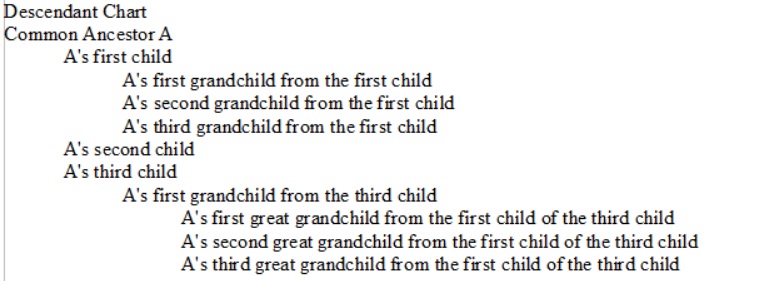
—
- Numeric Numbering Systems
There are a few very simple numbering systems for use with Descendant Charts, the Henry, the d’Aboville, and sequential.
The Henry system simply uses the position within the number as the generation and the number contained in that position as the child position within the family. This works fine until there are 10 or more children. At that point the Henry system uses parenthesis to indicate a number greater than a single position. This would create a number like 1313(10) if 1310 had 10 children.
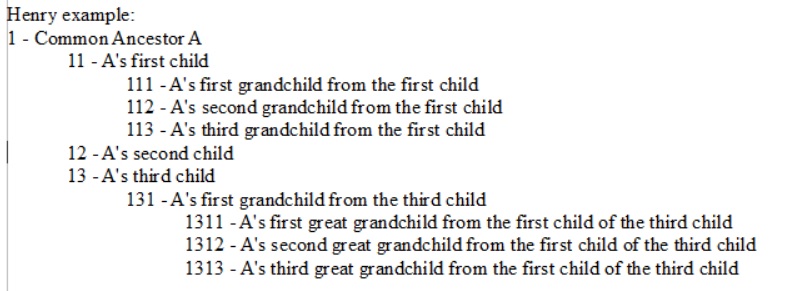
The d’Aboville system resolves the issue with multiple digit children, by simply delineating generations with periods. Thus, a single person could have over 100 children without problems. (Something some Kings may actually have accomplished in their lives.) So the problem with 1313’s with ten children family would be resolved to 1.3.1.3.10.
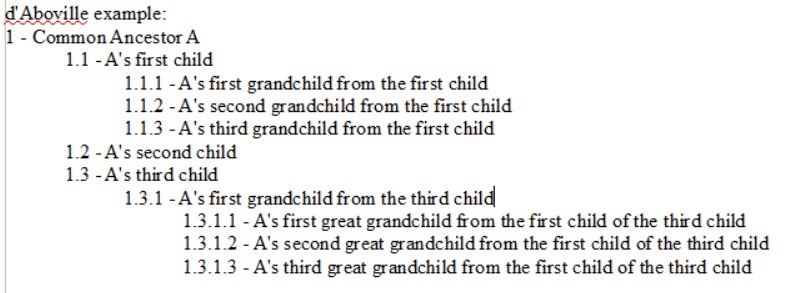
The d’Aboville appears to be by far the simplest and cleanest way to represent Descendant Charts. From a system perspective, not only is it simple, but in combination with automation, can make the task of renumbering far simpler than other methods. The big issue with all of these systems is in what happens when a child has been newly discovered and now children and descendants in lower positions within the family need to be renumbered.
Another numeric system not normally mentioned in most publications is a simple sequential number. This means that no matter what the position within any generation or any family, ancestors would be numbered with a sequential number which is unique to all individuals and carries no significance at all other than being the next ancestor to be numbered. Doing so is much like numbers assigned in desktop and repository software, but since there is no significance to the number, additional information is needed to supply that significance. Significance is what the other numbering systems do give, so sequential numbers are normally given to individuals in databases, but additional numbers such as the above are added as alternate numbers. The old PAF and Ancestral file numbers as well as the new Family Search IDs are good examples of sequential numbers.
- Roman Numeral Numbering Systems
The Register, NGSQ, and Meurgey de Tupigny Systems use both Arabic and Roman Numerals.
The Register system gives an Arabic number (normal decimal numbers) to those that have children and assigns Roman numbers to all children within the family. The NGSQ system gives an Arabic number to all children as well as Roman numbers. Arabic numbers continue to run in sequence, but Roman numbers restart at the start of each family.
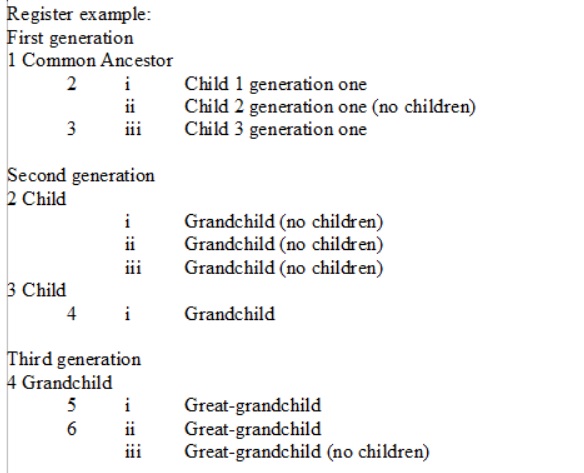
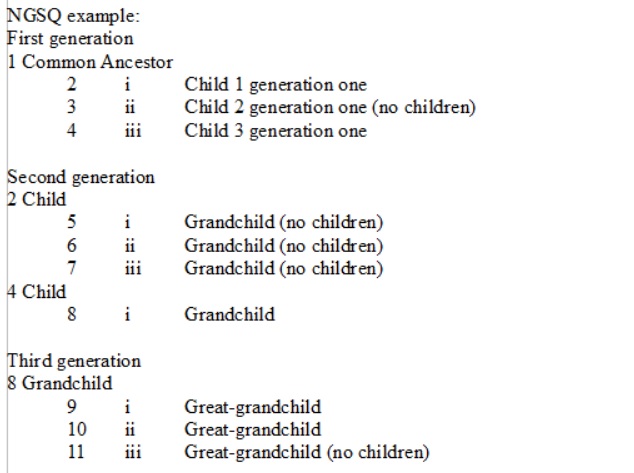
The Meurgey de Tupigny system switches things up a bit by embedding the generation in Roman Numerals and the child number in Arabic numbers. However, the Arabic numbers continue to run in sequence in the same generation.
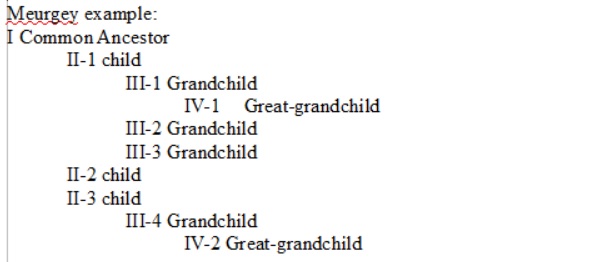
To be quite frank, the Roman Numeral system was abandoned centuries ago because of its inflexibility. I don’t suggest you use it for your own purposes, I’ve shown a couple of far easier ways above. But if you need to understand them because you are researching information already using them, such as the New England Historical and genealogical Register, you’ll need to research a little deeper into these systems.
- Alphabetic Numbering Systems
In addition to Arabic and Roman numbering systems, there are also numbering systems that explicitly specify the generation by alphabetic means. The de Villiers/Pama system is one of these. The de Villiers/Pama system gives letters to generations and numbers to child positions within the family. The following is an example of using de Villiers/Pama to translate the data in prior examples. The last child shown would be numbered b3.c1.d3.
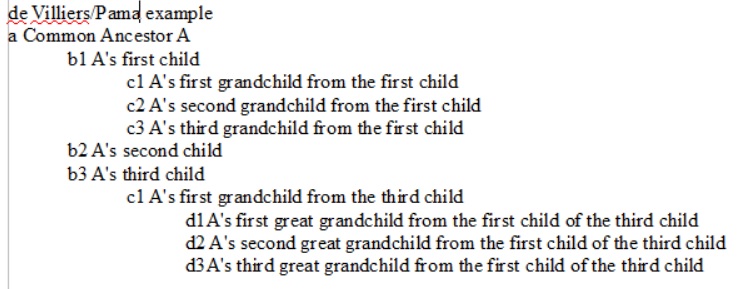
Although the de Villiers/Pama system does make it easier to handle generations than the Roman Numeral systems because it resets the child number within each family, it does just about the same thing that the d’Aboville system does, but requires additional characters to indicate the generation. So if the additional characters don’t add any information than is already there, is there a reason to use them?
- Last Name
But what if you need to show at a quick glance relationships between two different related people? One way would be to show graphically what the relationship is. This is what the FamilySearch View My Relationship utility does. It shows the people between yourself both up the Family line and down a lateral line to the person that is related to you, even if remotely. It is a numbering system showing both up and down family lines. However, it is not a textual system, it is a graphical representation of the relationships. So how do you represent the same thing using a numbering system? One way, the Last Name system, is to take the last name of each of the ancestors and delimit them with the > greater than sign wherever there is an ancestor relationship and a < less than sign wherever there is a descendant relationship.
So for example if the relationship were the following, where Smith is the start of the relationship and Bates is the end (where the * shows the tie between going up the family tree and down it):
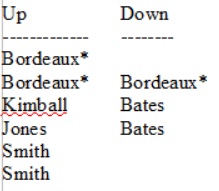
The Last Name numbering system would generate the following: Smith>Smith>Jones>Kimball>Bordeaux>Bordeaux<Bordeaux<Bates<Bates.
In explanation, Bordeaux would be the Parent of two sisters, one going up the tree, having married a Kimball, and the other gong down a lateral line, having married a Bates.
It can also be used to create Jagged relationships, such as going up a family tree, down a lateral line a number of generations, then back up again. I know of no other system having that ability.
If the relationship were the following:
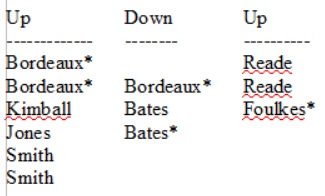
The number generated would be:
Smith>Smith>Jones>Kimball>Bordeaux>BordeauxFoulkes>Reade>Reade; Foulkes being the Mother of a Bates child.
The more unique the last names involved, the higher likelihood a completely unique number will be generated. Within a particular family organization, this system makes it fairly simple to trace through relationships, even when they become quite complex. It also makes it fairly simple to modify the number generated when retrofitting for use with descendants of the person that generated the number originally. You simply add a new last name to the front of the number. However, since siblings carry the same last name, not all numbers generated are unique. I created this system for use in logging entries in a personal Family History Research Log because it became very confusing to remember how each of the family members were related by just looking at the log itself. Jagged relationships became very time consuming to reestablish by referring to conventional graphical representation systems in either desktop or online repository utilities. However, it is possible that someone somewhere else may have come up with a similar numbering system which I am not aware of.
- Others
The above has been a detailed discussion of several numbering systems used in Family History. But please don’t think they are an extensive list. They were given as a way to show how Family History numbering systems work. If you can understand that concept, you’re well on your way to understanding the strengths and weaknesses of any system used within the Family History Realm.
There are additional systems that are used for specific purposes. They are briefly discussed below to give examples of other systems.
Library numbering systems help patrons locate library holdings. The following are a few: Dewey, Library of Congress, Universal Decimal Classification, Harvard-Yenching, Garside, Bliss, Nippon Decimal, Chinese Library, Korean, etc. Each of these may become important to you depending where you do your research.
Another type of numbering system important to Family History is the GEDCOM format. GEDCOM files are the result of exporting data from a Family History database. The GEDCOM format is a means of communicating the information and family relationships stored in the original database to another database which may not even use the same data structures. To the layman it is not necessary to understand the structure of the data, just understand that the export file you create from your database can be uploaded to your relative’s database and be understood and reconstructed into the new database structure because the GEDCOM format is a common format used for communications between database utilities and repositories. If you are a developer and wish to better understand the GEDCOM format, it is readily available on the internet listed under GEDCOM Specifications.
Hanging file folders are another important source of data. An effective way to order paper copies of artifacts, such as stories, birth, death and marriage certificates, obituaries, etc.,is to alphabetize the names of the individuals about which you are storing information, with last name, then first name and additionally a birth date. However, you may need to expand your numbering system if you have a lot more than one folder’s worth of papers for a single individual. Use your discretion, but simple alphabetization and birth date is probably the best method to start with.
Each system has strengths and weaknesses and you’ll need to choose the system to use depending on your own personal circumstances. You may even need to develop a numbering system of your own, as I did, in a manner that makes sense to you and conveys the knowledge to others simply and understandably. Don’t limit yourself, but do recognize the strengths and weaknesses of each.
—
Seekerz, © 2021
